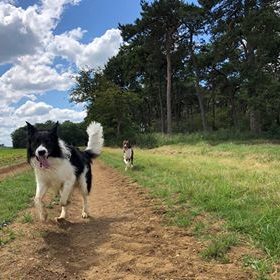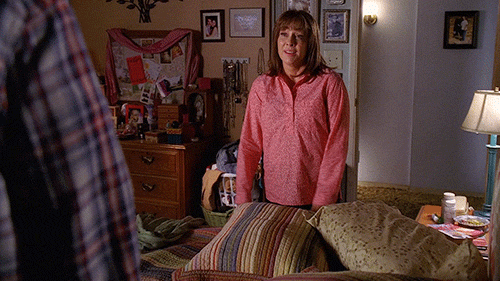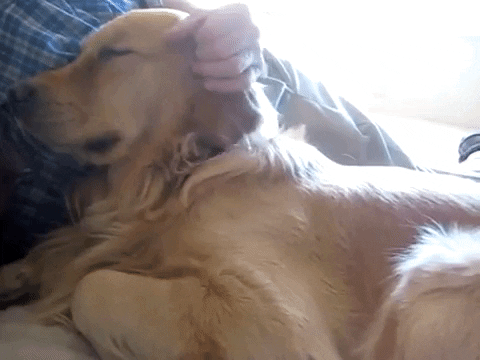
The modern-day myth about dogs – how long do I need to walk my dog for?
You want to make sure you are doing right by your dog. We totally get that – we are dog owners too and we adore our dogs!
How we work with dogs is continually shaped by the latest science and research and our developing understanding of dogs and their emotions.
Some of the concepts we teach are not ‘new’ as such, but we do place more emphasis on them than ‘traditional’ dog trainers might.
For example – many traditional dog trainers teach ‘alternative’ behaviours to deal with ‘undesirable’ behaviours.
Take for example a dog chasing a car. You might encourage the dog to heel at your side and create a strong heel position. However we know this isn’t foolproof, and actually, ends up being quite stressful for both owner and dog to achieve.
As modern concept trainers, we look at the dog’s emotional behaviour as a whole and teach the dog to think for themselves. Yep – dogs CAN be taught to think for themselves – we teach them all the time. That in itself is far more powerful and foolproof as you’ve actually changed and remoulded the dog’s brain, as opposed to putting a ‘sticky plaster’ on the undesirable behaviour.
This is just one example of where we see dog training can be greatly improved. But there is one dog training myth that stands out above them all.
So what is the biggest myth in dog training today?
Google and online forums have a lot to answer for when dog owners are looking for answers! One of the most common questions people ask online is ‘how long do I need to walk my dog for each day?’

Have you ever googled it?
It’s a question we also get asked. A LOT!
So what’s the answer?
THIS is one of the biggest myths in dog training today.
Often the answers you read online are breed-specific. Online you might find blogs recommending dogs are walked 1-3 times a day for between 30 and 90 minutes a time.
So a Border Collie owner might look at that and think they should go with the maximum recommendation. Three walks a day. 90 minutes each.
But it’s a Border Collie so surely it NEEDS those walks. It NEEDS that exercise, right?
Well as qualified dog trainers, with years of experience, and owners of both Border Collies and working Cocker Spaniels, we can tell you that ritualistic walking to ‘tire’ your dog out doesn’t work. And actually, it might be making those undesirable behaviours worse.
Two Dog Walking Examples
Let’s take two examples of the same dog that gets quite excited on a walk, whose recall is a bit hit and miss, and sometimes barks at things. He can chase cars when over-excited and pulls like a horse on lead.
Example 1
You take your dog for two 60 minute walks through your town every day which end up at a field for an off lead game of fetch with a ball. He doesn’t always come back when he sees another dog and sometimes you feel like he’s totally ignoring you. You’ve actually spent 30 minutes trying to get him back on lead before now. Sometimes he barks in excitement at people or dogs or chases cars on the way back. He pulls a lot, and you end up pulling him away from things he’s really enjoying sniffing as you can’t get his attention and he just won’t move. Near the end of the walk he tries to chase the local cat. You feel a bit exhausted.

Example 2
You take your dog for a 30-minute walk up to your local wooded quiet sniffy lane. You drove there because he sometimes chases cars and you are working on that chase drive at home right now so you don’t want him to rehearse that. You really enjoy the 30 minutes with him. You play a few focus games while you are there. A nose touch which you are starting to get some duration out of! You can’t wait to tell your training group.
You play middle (he really loves that!) and then you play a few lead games so that when he feels pressure on the lead he knows to stay close and come with you. You decide to walk out of the lane today and trial a bit of lead walking on the path – his checking in with you is amazing! The training is really paying off. You head back to the lane to finish your walk.
Later that evening after work you scatter feed some of his dinner in the garden while you make tea and then you practice some lead walking games. You also know how important it is to keep those muscles in good shape so you do a few fitness games too.
After dinner he settles down with a frozen filled kong which takes him about 30 minutes to finish. He’s pretty tired but he doesn’t settle just yet – but you have that tasty pizzle on standby! He chews that for another 20 minutes and then promptly falls asleep.
So after reading those two examples let’s look at the facts and how they affect this dog
FACT: Dogs need exercise
Yes, they do. They need exercise and they need it in a healthy and stimulating way that is going to grow them in the right direction. If you are looking at your walks right now and they aren’t feeling very enjoyable, and you feel like your dog is actually running riot more than focusing on you, then it’s time to ditch those walks and exercise at home while you work on training. You aren’t going to ditch them forever! You just need to know that right now, it’s not helping your dog get to where you want them to be.
You can play energetic games as well as fitness training at home to keep your dogs in tip top shape. Or maybe you can drive to somewhere quieter for now? Be a gamechanger and think outside of the box.
FACT: Dogs need mental stimulation
Mental stimulation is working your dog’s brain. Throwing a ball for them (as fun and as rewarding as it is) isn’t mentally stimulating on its own. Your dog needs more. Your dog would love for you to play some games with them that are going to work their mind and keep them busy. Training games do just that.
FACT: Dogs need rest
Dogs need to know how to rest. We can help promote that by giving them long-lasting treats like frozen hoofs to promote and grow calmness. Not all dogs have the ‘grit’ to finish a frozen treat and so we build up those skills gradually so that eventually they WILL sit there for 30 minutes until it’s all gone – which in itself is super tiring and mentally stimulating.

FACT: Dogs need to chew
Chewing actually decreases cortisol in your dog’s body. So exciting or worrying things that have happened during the day, can be counterbalanced with chews. Dogs naturally LOVE to chew. It keeps boredom at bay and it’s very relaxing and calming for them.
FACT: Dogs prefer to work for their food (it’s called contra freeloading)
Giving your dogs their food in a bowl feels like a wasted opportunity when there are so many ways we want to grow them. Plus they prefer to work for it! Using your dogs daily allowance on their training (even scatter feeding) is far more beneficial for their brains and helps to accelerate their training.
In summary
- If walks aren’t growing your dog right now, or are feeling pretty stressful for you both, then it might be time to ditch them.
- If you aren’t well or your dog is on bed rest then you can ditch them.
- If your dog loves walks, and you find them stress-free and relaxing then there is no need to ditch them!
- The point is that all dogs are different. The important question to ask yourself is what are you doing right now? Are you growing your dog in the direction you want them to go? And if the answer is no, what could you do differently?
If you want to join our amazing community of like-minded dog owners from Peterborough and all over the world, to deep dive into your dog’s struggles and turn them into their strengths. All whilst having tons of fun, then take a look at our membership or join us for your first free class by filling out this form.
We’d love to welcome you to the On The Ball family!
